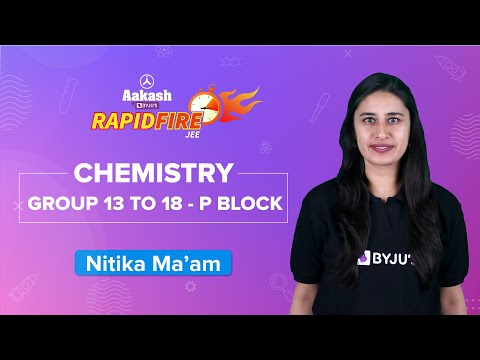Class 12 chemistry MCQs with answers are provided here for chapter 7 The p-Block Elements. These MCQs are based on the CBSE board curriculum and correspond to the most recent Class 12 chemistry syllabus. By practising these Class 12 Multiple choice questions, students will be able to quickly review all of the ideas covered in the chapter and prepare for the Class 12 Annual examinations as well as other entrance exams such as NEET and JEE.
Download Chapter 7 The p-Block Elements MCQs PDF by clicking on the button below.
Download PDF
Class 12 The p-Block Elements MCQs
1. What is created by the reaction of natural gas and steam in the Haber-Bosch process?
a) Ammonia
b) Nitrogen
c) Oxygen
d) Hydrogen
Answer: d
Explanation: The steam reformation of methane is the reaction of natural gas and steam. It is a critical stage in the Bosch-Haber (industrial ammonia production process), which creates hydrogen gas, H2, as one of the two reactants alongside nitrogen in the production of ammonia in the presence of an iron catalyst.
2. What form does nitrogen take in plants?
a) Ammonia
b) Amide
c) Nitrate
d) Nitrite
Answer: c
Explanation: Plants mostly absorb nitrogen in the form of nitrate ions, as well as ammonium ions. This is provided to them through fertilizers, such as ammonium phosphate and calcium ammonium nitrate.
3. What happens to the size of atoms in p-block elements when we move from left to right in the same period?
a) Size does not change
b) Size increases then decreases
c) Size increases
d) Size decreases
Answer: d
Explanation: The size of the atoms of the elements decreases from left to right throughout the same time period. The electrons are added to the same shell because the row is the same. On the other side, an increase in atomic number corresponds to an increase in protons or positive charge. The overall effective nuclear charge rises as a result. As a result, the electron cloud is drawn closer to the nucleus of the atom. As a result, the size of the object decreases.
4. When copper chips are exposed to concentrated nitric acid, which gas is produced?
a) Nitrogen (III) oxide
b) Nitrogen (IV) oxide
c) Nitrogen (I) oxide
d) Nitrogen (II) oxide
Answer: b
Explanation: The deadly brown gas, NO2, nitrogen (IV) oxide, is released when copper chips are treated with strong nitric acid. It’s a pungent-smelling reddish-brown gas.
5. When ammonia is oxidized to form nitric acid, what catalyst is used?
a) Platinum-Rhodium gauze
b) Vanadium (V) oxide
c) Palladium hydride
d) Sodium amalgam
Answer: a
Explanation: At a temperature of 500 K and a pressure of 9 bars, ammonia is oxidized to nitrogen (II) oxide in the presence of a Pt/Rh gauze catalyst. After that, the nitrous oxide is transformed to nitrogen dioxide, which is subsequently reacted with water to produce nitric acid. The NO that is produced is recycled.
6. Which of the following statements about Hypophosphorous acid is incorrect?
a) It is also called phosphonic acid
b) The oxidation state of phosphorus is +1
c) It is monobasic
d) It is represented by the formula H3PO2
Answer: a
Explanation: The oxoacid of phosphorus hypophosphorous acid, commonly known as phosphinic acid, has a phosphorus oxidation state of +1. In nature, it is monobasic, meaning it dissociates into one hydrogen ion. H3PO2 is the chemical formula for it.
7. Which of the following compounds has an oxidation state of +5 phosphorus?
a) Peroxodiphosphoric acid
b) Hypophosphorous acid
c) Orthophosphorous acid
d) Hypophosphoric acid
Answer: a
Explanation: Phosphorus in peroxodiphosphoric acid has an oxidation state of +5. Phosphorus has an oxidation state of +1 in hypophosphorous acid, +3 in orthophosphorous acid, and +4 in hypophosphoric acid.
8. Why is nitrogen preferred in the welding and cooling of materials?
a) It is an inert gas
b) It is non-toxic
c) It’s a gas and can easily be handled
d) It has an extremely low freezing point
Answer: a
Explanation: Non Toxic gasses such as argon are also available. Nitrogen gas, on the other hand, is still the favoured gas since it prevents any undesirable oxidation or explosions. This prevents metals from corroding in the welding business. Nitrogen is utilized in food packaging because it creates a pressured environment that prevents container collapse.
9. The term ‘pnictogens’ refers to which group?
a) Group 15
b) Group 14
c) Group 11
d) Group 13
Answer: a
Explanation: The ‘pnictogens’ are the elements in group 15 of the periodic table. The word pnicogen means ‘to choke.’ Because all of the elements in this category choke in nature, including nitrogen’s choking property. Group 11 doesn’t have a name, however group 13, is known as the Boron group. The Carbon group is the 14th group.
10. Producer gas is defined as which of the following mixtures?
a) carbon dioxide and hydrogen
b) carbon monoxide and hydrogen
c) carbon monoxide and nitrogen
d) carbon dioxide and nitrogen
Answer: c
Explanation: Producer gas is a mixture of carbon monoxide and nitrogen, while water gas is a mixture of carbon monoxide and hydrogen. Carbon mixes with oxygen and nitrogen to make producer gas at 1273 K.
Recommended Videos

Comments